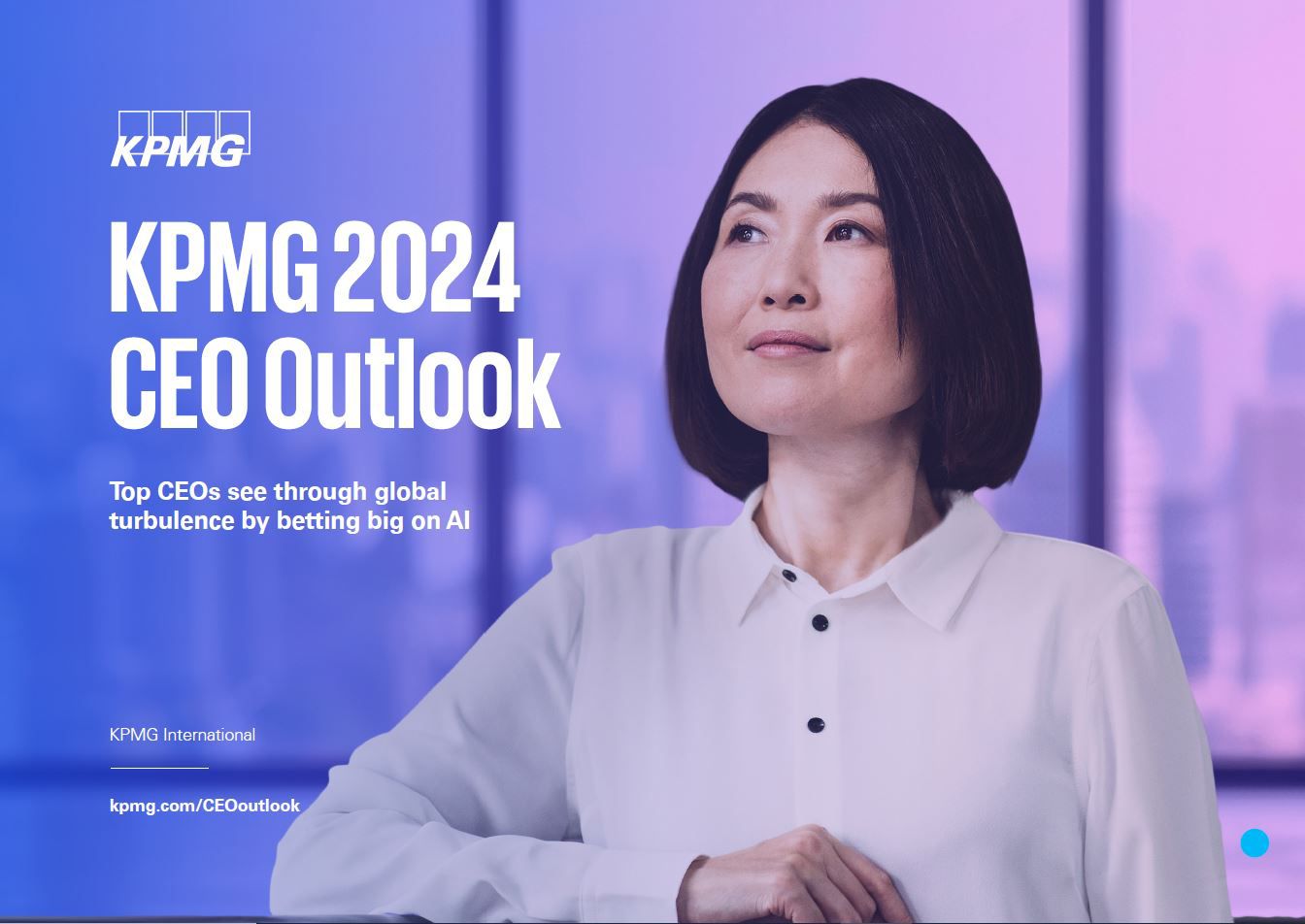Top CEOs see through global turbulence by betting big on AI
Navigating a decade of disruption: Ten years of the KPMG CEO Outlook research shows CEO confidence in their organization’s future, despite geopolitical and economic volatility.
From the race to embrace artificial intelligence (AI) to ever-mounting geopolitical concerns, the challenges faced by the CEOs of today are vast and complex. Alongside these external pressures, internal challenges such as upskilling the workforce and hybrid working are pushing CEOs to be agile and adaptable in their stakeholder management while also keeping an eye on long-term growth.
First launched globally 10 years ago, the KPMG CEO Outlook surveys more than 1,300 global business leaders overseeing companies with revenues of at least US$500M from some of the world’s biggest economies and key industries. In 2024, we’ve surveyed 1,325 global business leaders – including 25 from Sweden. We will continuously update this page with key insights from the Swedish CEOs.
The last 10 years have been defined by volatility, ranging from the economic and social shockwaves of the COVID-19 pandemic to the resurgence of inflation and geopolitical tensions. In the face of this, leaders have had to adapt to an unprecedented array of challenges that have not only placed greater pressure on CEOs’ shoulders but driven a waning of confidence in the global economy.
Yet, global leaders remain resilient, leading their businesses on a path to sustainable growth. Global leaders continue to create a solid foundation by betting big on AI and bolstering their workforce to adapt to evolving business needs. This year’s survey shows that CEOs are optimistic about their organization’s future, with 92 percent of leaders looking to increase the overall headcount of their workforce, but also recognizing they need to future proof the skillsets of their people and demonstrate increased employee value proposition to attract and retain talent. Balancing ambition and appropriate caution will be key when it comes to ESG issues if CEOs want to avoid stakeholder criticism and, more importantly, do the right thing.
A Swedish lens over CEO Outlook
This year, we have included 25 CEOs from major Swedish companies. The survey shows that Swedish CEO’s have a positive outlook on the financial growth for the next three years but are worried by geopolitical threats and political uncertainties.
- 8 out of 10 Swedish CEOs are optimistic about industry growth, while 7 out of 10 are positive about their own company's growth in the next three years.
- Over 80% of Swedish CEOs, and 76% globally, believe genAI will not reduce employee numbers but will require training and adaptations.
- Swedish CEOs, like global leaders, prioritize investments in new technology (68%) and employee skills development (32%).
- 24% of Swedish CEOs see geopolitical and political uncertainties as major threats to growth, higher than CEOs globally (12%) and in Europe (15%).


We see that today's business climate and an increasingly dynamic and demanding external environment place high demands on CEOs, who today need to be more strategic, adaptable, and innovative than ever before. Swedish CEOs are adjusting their growth strategy according to the current economic climate and geopolitical situation and remain confident about financial development.

Christoffer Sellberg
Partner, Head of Clients & Markets
KPMG in Sweden

CEO confidence in the global economy (2015-2024)
How 2024’s top threats to growth have evolved over the last ten years
*Note 1 equals the top risk.
**In 2022 operational issues were not included as a risk option in the survey.
Top risks over the last ten years
- Cyber security
- Operational issues
- Emerging/disruptive technology
- Geopolitics and political uncertainty
- Environmental/climate change
- Supply chain
- Regulatory concerns
- Strategic risk
- Reputational/brand
Top threats to growth according to Swedish CEO's:
1. Geopolitical and political uncertainty
2. Emerging/disruptive technology
3. Operational issues
Ten years of survey data demonstrates how leaders have sought to create confidence in business growth, from increased investment in innovation and tech, to placing a fresh focus on the employee value proposition and renewing their commitment to ESG and sustainability as a source of value creation. Looking more closely at the next three years, respondents identified their top operational priorities as advancing digitization and connectivity across their business (18 percent), understanding and implementing generative AI across the business and upskilling their workforce (13 percent), and execution of ESG initiatives (13 percent). By futureproofing their business for a digital world and focusing on fostering and retaining great talent, CEOs not only address their immediate operational needs but also position their organizations for sustainable, organic growth.

For the CEOs surveyed, technological innovation has been the single most disruptive force over the past 10 years, with emerging and disruptive technology landing as a top three risk to growth in six of the past nine surveys.
When KPMG first launched the CEO Outlook a decade ago, AI was gaining traction with breakthroughs in areas such as image recognition, natural language processing and autonomous vehicles. In 2024, the majority (64 percent) of global CEOs indicated that they would invest in AI regardless of economic conditions. And while today’s AI use-cases generate plenty of buzz in the public discourse, global CEOs recognize the need to seize the challenges that lie ahead, considering AI’s potential to transform every aspect of our everyday life.
Workforce upskilling a key piece of the AI puzzle
Despite public concern around the risk of redundancies, CEOs recognize the transformative potential of AI and remain confident that it will not have a detrimental impact on the workforce, with over three quarters (76 percent) of CEOs anticipating AI will not fundamentally reduce the number of jobs within their organizations over the next three years. Yet, CEOs also recognize their workforce will need to adapt to fully harness the opportunity, as when asked about their organization’s current AI readiness, only 38 percent of CEOs were confident that their employees have the right skills to fully leverage the benefits. Furthermore, 58 percent agree that the integration of generative AI has made them rethink the skills required for entry-level roles.
Where CEOs invest will be key
This growing commitment to AI shows that global CEOs are building on the capital expenditure momentum witnessed last year, as all CEOs say they plan to invest in AI in some form. They recognize AI’s potential to increase efficiency and productivity (16 percent), upskill the workforce for future readiness (14 percent) and increase organizational innovation (13 percent). However, a majority of CEOs (63 percent) acknowledge an ROI on AI is unlikely for at least three to five years — in line with last year.
Ethical implementation of AI a concern for most
Amid growing concerns about the ethical use and implementation of AI, CEOs are increasingly aware of the risks tied to its rapid adoption. Well over half (61 percent) identified ethical challenges as some of the most difficult issues to address when implementing AI within their businesses — an increase from 57 percent in 2023. Additionally, concerns over a lack of regulation (50 percent) and insufficient technical skills and capabilities (48 percent) further complicate the path forward.

Since 2015, as employees have demanded more flexibility in working patterns and a stronger alignment between personal beliefs and organizational purpose, successful leaders have adapted well to this shifting workforce dynamic. The leaders who prosper are those who put people at the heart of their growth strategy and evolve their social contract to keep up with the evolving expectations of current and future talent.
However, the leaders surveyed show that the return-to-office debate continues to give food for thought. This years’ findings reveal that CEOs are hardening their stance on returning to pre-pandemic ways of working, with 83 percent expecting a full return to the office within the next three years — a notable increase from 64 percent in 2023. And this expectation only increases with age: 75 percent for those aged 40 to 49, 83 percent for those aged 50 to 59, and 87 percent for those aged 60 to 69. Interestingly, there is also a gender split emerging in this debate: while 84 percent of male CEOs predict a full return to the office within three years, only 78 percent of female CEOs anticipate the same shift back. Furthermore, 87 percent of respondents say they are likely to reward employees who make an effort to come into the office with favorable assignments, raises or promotions.
Overall percentage of CEOs predicting a full return to office over the next three years
CEOs also acknowledge that other talent-related issues could affect future growth and competitiveness. Almost a third of them say they are concerned about labor market shifts — specifically the number of employees that will soon retire, and the lack of skilled workers available to replace them. In response to this talent shortage, 80 percent of CEOs agree that organizations should be investing in skills development and lifelong learning within local communities to help safeguard access to future talent. With this local commitment, 92 percent of leaders hope this will help to increase the overall headcount of their workforce over the next three years.
CEOs three-year outlook on expected headcount growth from 2015 to 2024

This year’s findings expose the reality of navigating environmental, social and governance priorities in today’s climate. Alongside a growing awareness of ESG’s impact on trust and reputation, the increasingly politicized nature of the ESG agenda is heightening the pressure felt by today’s leaders.
In 2015, CEOs ranked environmental risk as their least concerning priority risk; fast-forward to 2024 and almost a quarter (24 percent) acknowledged that the principal downside of failing to meet ESG expectations would be giving their competitors an edge, coming out ahead of threat to their own tenure (21 percent) and recruitment challenges (16 percent).
It’s clear that leaders are willing to take action when it comes to ESG, with three quarters (76 percent) of CEOs saying they would be willing to divest a profitable part of the business that was damaging their reputation. More tellingly, a majority (68 percent) indicate that they would take a stance on a politically or socially contentious issue, even if the Board raised concerns with them doing so. The survey also shows that today’s CEOs recognize just how vital ESG is to value creation — just under a quarter (24 percent) cite giving their competitors an edge as the principal downside of failing to meet ESG expectations.
Two-thirds of CEOs admit they aren’t prepared to withstand the potential scrutiny and expectations of shareholders when it comes to ESG, suggesting they will take action to mitigate this. Interestingly, there are emerging generational differences among CEOs, with 43 percent of younger leaders (aged between 40 and 49) feeling more confident they can take on scrutiny around ESG compared to 33 percent of CEOs aged 50-59 and 30 percent of those aged 60 to 69.
We’re also seeing a growing level of politicization and polarization of issues such as social mobility and climate change, and it’s creating challenges for CEOs who are already under pressure to meet or reassess established targets. As a result, some global CEOs are shifting how they communicate their ESG efforts. In this year’s survey, 69 percent reveal that while they’ve retained the same climate related strategies over the last 12 months, they’ve adapted the language and terminology they use internally and externally to meet changing stakeholder needs. For example, political and social forces have pushed some businesses to change the language they use, with some organizations preferring to use general terminology such as “sustainability” over the more encompassing term of “ESG.”
Swedish CEO's perspective on ESG
- 56% have evolved their strategy to meet changing stakeholder needs.
- 48% believe it is possible to address all of their ESG priorities simultaneously.
- 44% believe they will see a significant rate of return on their ESG investments within 5-7 seven years.
CEOs' perspectives on ESG
Finally, 30 percent say the greatest barrier to achieving their climate ambitions is the complexity presented by the decarbonization of their supply chain — an issue further compounded by current geopolitical tensions around the world and activities impacting major global trade routes. As we head into 2025, it will be interesting to see how this impacts opinions and organizations overall, as ESG reporting begins to take hold across the globe.

KPMG 2024 CEO Outlook
Top CEOs see through global turbulence by betting big on AI.
Download report ⤓
Further readings
Methodology
About the KPMG 2024 CEO Outlook
The 10th edition of the KPMG CEO Outlook, conducted with 1,325 CEOs between 25 July and 29 August 2024, provides unique insight into the mindset, strategies and planning tactics of CEOs.
All respondents have annual revenues over US$500M and one-third of the companies surveyed have more than US$10B in annual revenue. The survey included leaders from 11 markets (Australia, Canada, China, France, Germany, India, Italy, Japan, Spain, the United Kingdom and the United States) and 11 key industry sectors (asset management, automotive, banking, consumer and retail, energy, infrastructure, insurance, life sciences, manufacturing, technology and telecommunications).
NOTE: Some figures may not add up to 100 percent due to rounding.



